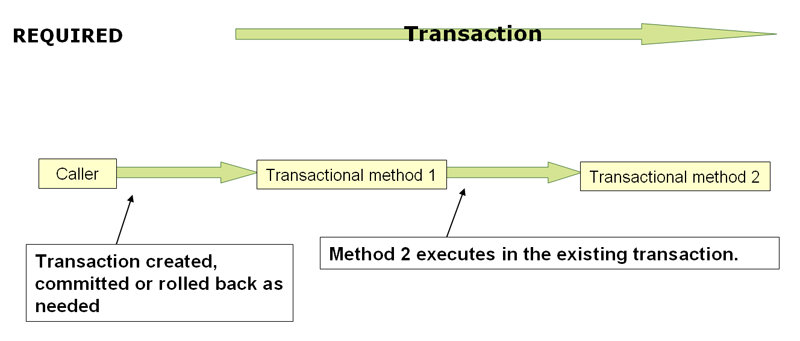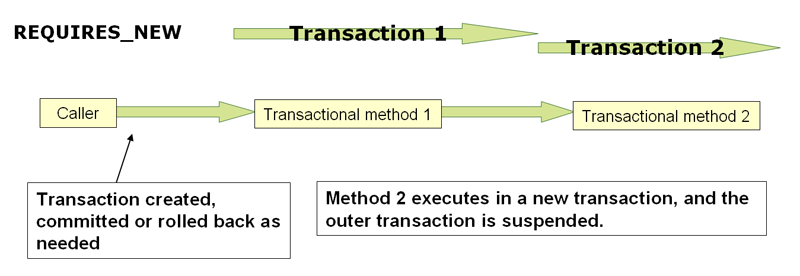|
For the latest stable version, please use Spring Framework 7.0.2! |
Transaction Propagation
This section describes some semantics of transaction propagation in Spring. Note that this section is not a proper introduction to transaction propagation. Rather, it details some of the semantics regarding transaction propagation in Spring.
In Spring-managed transactions, be aware of the difference between physical and logical transactions, and how the propagation setting applies to this difference.
Understanding PROPAGATION_REQUIRED

PROPAGATION_REQUIRED enforces a physical transaction, either locally for the current
scope if no transaction exists yet or participating in an existing 'outer' transaction
defined for a larger scope. This is a fine default in common call stack arrangements
within the same thread (for example, a service facade that delegates to several repository methods
where all the underlying resources have to participate in the service-level transaction).
By default, a participating transaction joins the characteristics of the outer scope,
silently ignoring the local isolation level, timeout value, or read-only flag (if any).
Consider switching the validateExistingTransactions flag to true on your transaction
manager if you want isolation level declarations to be rejected when participating in
an existing transaction with a different isolation level. This non-lenient mode also
rejects read-only mismatches (that is, an inner read-write transaction that tries to participate
in a read-only outer scope).
|
When the propagation setting is PROPAGATION_REQUIRED, a logical transaction scope
is created for each method upon which the setting is applied. Each such logical
transaction scope can determine rollback-only status individually, with an outer
transaction scope being logically independent from the inner transaction scope.
In the case of standard PROPAGATION_REQUIRED behavior, all these scopes are
mapped to the same physical transaction. So a rollback-only marker set in the inner
transaction scope does affect the outer transaction’s chance to actually commit.
However, in the case where an inner transaction scope sets the rollback-only marker, the
outer transaction has not decided on the rollback itself, so the rollback (silently
triggered by the inner transaction scope) is unexpected. A corresponding
UnexpectedRollbackException is thrown at that point. This is expected behavior so
that the caller of a transaction can never be misled to assume that a commit was
performed when it really was not. So, if an inner transaction (of which the outer caller
is not aware) silently marks a transaction as rollback-only, the outer caller still
calls commit. The outer caller needs to receive an UnexpectedRollbackException to
indicate clearly that a rollback was performed instead.
Understanding PROPAGATION_REQUIRES_NEW

PROPAGATION_REQUIRES_NEW, in contrast to PROPAGATION_REQUIRED, always uses an
independent physical transaction for each affected transaction scope, never
participating in an existing transaction for an outer scope. In such an arrangement,
the underlying resource transactions are different and, hence, can commit or roll back
independently, with an outer transaction not affected by an inner transaction’s rollback
status and with an inner transaction’s locks released immediately after its completion.
Such an independent inner transaction can also declare its own isolation level, timeout,
and read-only settings and not inherit an outer transaction’s characteristics.
The resources attached to the outer transaction will remain bound there while
the inner transaction acquires its own resources such as a new database connection.
This may lead to exhaustion of the connection pool and potentially to a deadlock if
several threads have an active outer transaction and wait to acquire a new connection
for their inner transaction, with the pool not being able to hand out any such inner
connection anymore. Do not use PROPAGATION_REQUIRES_NEW unless your connection pool
is appropriately sized, exceeding the number of concurrent threads by at least 1.
|
Understanding PROPAGATION_NESTED
PROPAGATION_NESTED uses a single physical transaction with multiple savepoints
that it can roll back to. Such partial rollbacks let an inner transaction scope
trigger a rollback for its scope, with the outer transaction being able to continue
the physical transaction despite some operations having been rolled back. This setting
is typically mapped onto JDBC savepoints, so it works only with JDBC resource
transactions. See Spring’s DataSourceTransactionManager.

